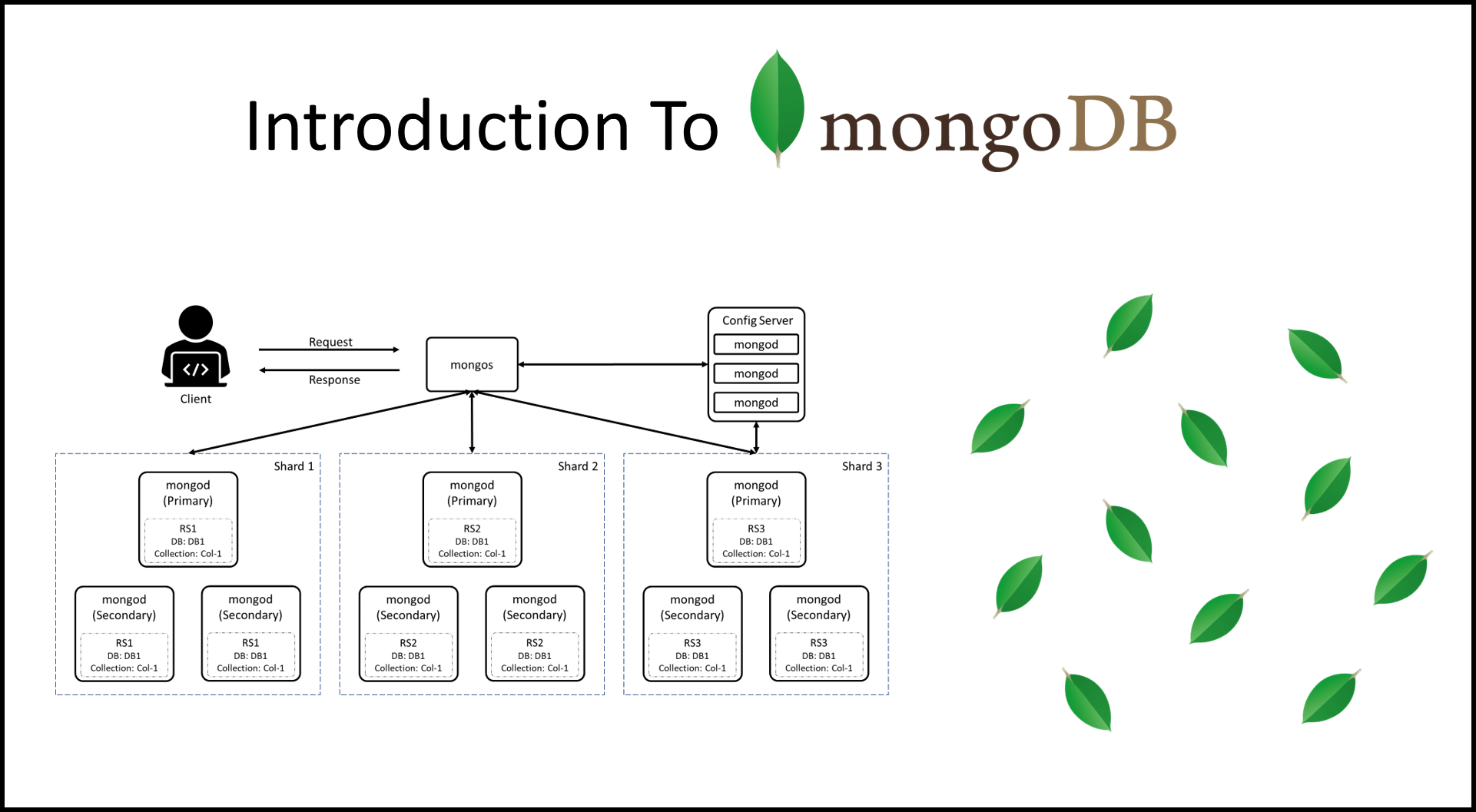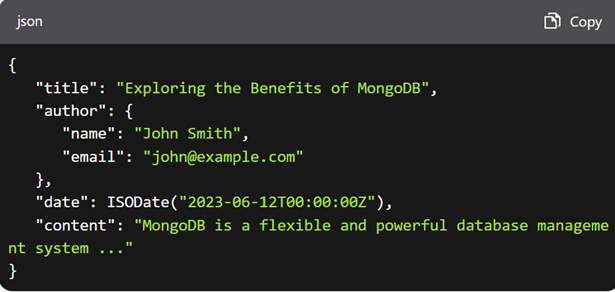The Benefits of MongoDB Database Management System
MongoDB is a tableless (NoSQL) and open-source database management System that stores, manages, and accesses document data based on JSON (JavaScript Object Notation). MongoDB was launched in 2009 by MongoDB Inc. It is developed.
In MongoDB, data is stored as documents in the database. Each document contains one or more fields, each of which contains a value. Fields can be different types, such as numbers, strings, dates, etc. Also, in MongoDB, a document can contain one or more subdocuments.
MongoDB executes queries and commands using JavaScript. This database management system can also support various programming languages, such as Python, Java, and Ruby.
Due to its flexibility and high scalability, MongoDB is used in many applications, such as content management systems, online stores, data analysis applications, etc. This database management system is also used in many websites and applications due to its high speed, stability, and flexibility.
Generally, MongoDB is a tableless database management System used to store and manage JSON-based document data. Its most important features include its ability to support different programming languages, high speed, stability, and flexibility.

Advantages of MongoDB
As a tableless database management System (NoSQL), MongoDB has many advantages over relational database management systems (RDBMS). Below are some of these benefits:
1- Scalability
Scalability means the system’s ability to increase the capacity of data processing and storage by increasing its volume. To clarify, scalability refers to the system’s ability to add new resources and distribute the parallel load among these resources.
MongoDB is easily scalable with a flexible structure and the ability to add new servers. This means new servers can be easily added to the System as the data volume increases. As a result, it can improve scalability.
Adding new servers to the system easily increases the data storage and processing capacity, establishing parallel loads between the servers.
Also, MongoDB uses techniques such as load balancing (sharding) that allow developers to distribute data across multiple servers. Using load balancing, data can be stored in parallel on different servers, which could increase scalability in MongoDB.
Increasing scalability in MongoDB generally improves System performance and increases the ability to manage large data. By using MongoDB, this advantage can be used to support applications that require large amounts of data and increase scalability.
2- NOSQL Support
MongoDB is a NoSQL database that uses the document model. In other words, data is stored as documents in MongoDB. This data model allows developers to work with data easily and respond dynamically to new data.
One advantage of using a NoSQL database such as MongoDB is that these types of databases are suitable for applications that require large volumes of data and greater flexibility in data storage and retrieval. Also, due to their non-relational structure, NoSQL databases such as MongoDB support the ability to add new data quickly and conveniently.
In MongoDB, NoSQL support allows developers to work with data and dynamically respond to new data easily. MongoDB also allows developers to access data directly at the document level.
Overall, MongoDB’s NoSQL support allows developers to easily work with large volumes of data and meet their application needs with the right data type.
3- Speed
MongoDB has advantages such as high speed in data storage and retrieval operations. This high speed is replaceable due to the internal structure and the use of information storage space (Storage Engine). This technology, due to storing data in BSON Format to transfer JSON data and having features such as index, full-text search, and advanced analysis (Aggregation Framework), is the default is fast.
In MongoDB, a data storage space like WiredTiger is used, which has features like data compression, transaction management, support for binary indexes, etc. MongoDB also uses its query Network called MQL (MongoDB Query Language). This feature allows developers to work with data and dynamically respond to new data easily.
This technology also uses techniques such as load balancing (sharding), which allows developers to distribute data between different servers. By using load balancing, data can be stored in parallel on different servers, which can increase scalability and data processing speed in MongoDB.
In general, the high speed of storage operations and data mining allows developers to work with large and complex data and store and retrieve their data faster and more efficiently.
4- Support Charging Methods
MongoDB uses sharding to support the System’s parallel processing and load distribution. In this method, the data is divided into several parts or charges based on a key (for example, a specific field in the document), and different servers are used to process each part. This allows developers to increase scalability by adding new servers to the System and working with large and complex data.
Using the charging method in this technology allows developers to store and process different parts of data in parallel on different servers. This improvement in system performance increases scalability in MongoDB. Also, by using load balancing, data can be stored in parallel on different servers, which can increase scalability in MongoDB.
In general, MongoDB’s support for charging methods allows developers to work with large and complex data and to increase scalability by adding new servers to the system.
5- Synchronization
MongoDB uses several methods to synchronize data. One of these methods is Replication, which allows developers to replicate data between several servers and automatically perform data recovery in case one of the servers fails.
In the replication method, data is replicated synchronously between different servers. Any changes made on one of the servers are also automatically applied to the other servers. Therefore, in case of the failure of one of the servers, the data is automatically restored to the other servers, and users are transparently protected from the failure of the main server.
Other methods, such as load balancing, are also used in MongoDB, which increases scalability and synchronizes data between different servers. Using load balancing, data can be stored in parallel on different servers, which could increase the scalability and synchronization of data in MongoDB.
In general, data synchronization in MongoDB using methods such as replicas and load balancing allows developers to work with large and complex data and automatically recover data in the event of a server failure.
6. Flexible Data Model
One of MongoDB’s key advantages is its flexible data model. In traditional relational databases, data is stored in tables with rows and columns, and the schema must be defined in advance. This approach works well for structured data, but it can be limiting for applications that deal with unstructured or semi-structured data.
In contrast, MongoDB uses a document-oriented data model, storing data as documents, similar to JSON (JavaScript Object Notation) objects. Each document consists of a set of key-value pairs, where the key identifies the data element and the value contains the data itself. Documents in MongoDB can be nested and contain arrays and other complex data types, allowing for the storage of complex and unstructured data.
For example, consider a blog application that uses MongoDB to store blog posts. In a traditional relational database, the schema must be defined in advance, with columns for the post title, author, date, and content. However, with MongoDB, each blog post can be stored as a document with the following fields:

The document contains fields for the post title, author (nested document), date, and content in this example. The schema is flexible and can be easily expanded to include additional fields without requiring changes to the database structure.
This flexible data model makes MongoDB well-suited for applications that deal with unstructured or semi-structured data, such as social media platforms, mobile applications, and e-commerce websites. It also makes it easier to develop and maintain applications, as changes to the data model can be made without requiring changes to the database schema.
7- Reliability
MongoDB is highly reliable for data storage and management. This capability is achieved through various methods, including replication, transactions, backup, and data recovery.
One method MongoDB uses to increase reliability is replication. In this method, data is replicated synchronously between different servers. Any changes made on one of the servers are also automatically applied to the other servers. Therefore, in case of the failure of one of the servers, the data is automatically restored to the other servers, and users are transparently protected from the failure of the main server.
ACID transactions are also supported in MongoDB. This means that transactions in MongoDB are atomic. They are completely done and confirmed, or none of their changes have been applied. This feature allows developers to work with large and complex data and have high confidence in their data.
MongoDB also uses powerful backup and recovery methods, which allow developers to easily back up and restore their data when needed.
8- Security
MongoDB has high-security advantages for data storage and management. This capability is achieved through various methods, including encryption, access management, advanced Security posture, and support for secure networks.
One method this technology uses to increase security is data encryption. MongoDB uses AES key-based encryption, which allows developers to encrypt their sensitive data in the database.
MongoDB also uses comprehensive access management to protect data. Using data-based permissions, developers can restrict user access to various data and operations. MongoDB also uses input and output monitoring, intrusion detection, suspicious activity, and other critical events to ensure data Security.
This technology also uses advanced security modes to support data security. These features include limiting data access, assigning roles, setting time limits for data access, detecting and tracking security threats, and managing external access to data.
MongoDB also supports secure networks, including SSL/TLS, SSH, and VPN, which allow developers to access their data using these networks.
Overall, MongoDB generally uses methods such as encryption, access management, advanced security posture, and support for secure networks, allowing developers to easily protect their sensitive data in the database.
